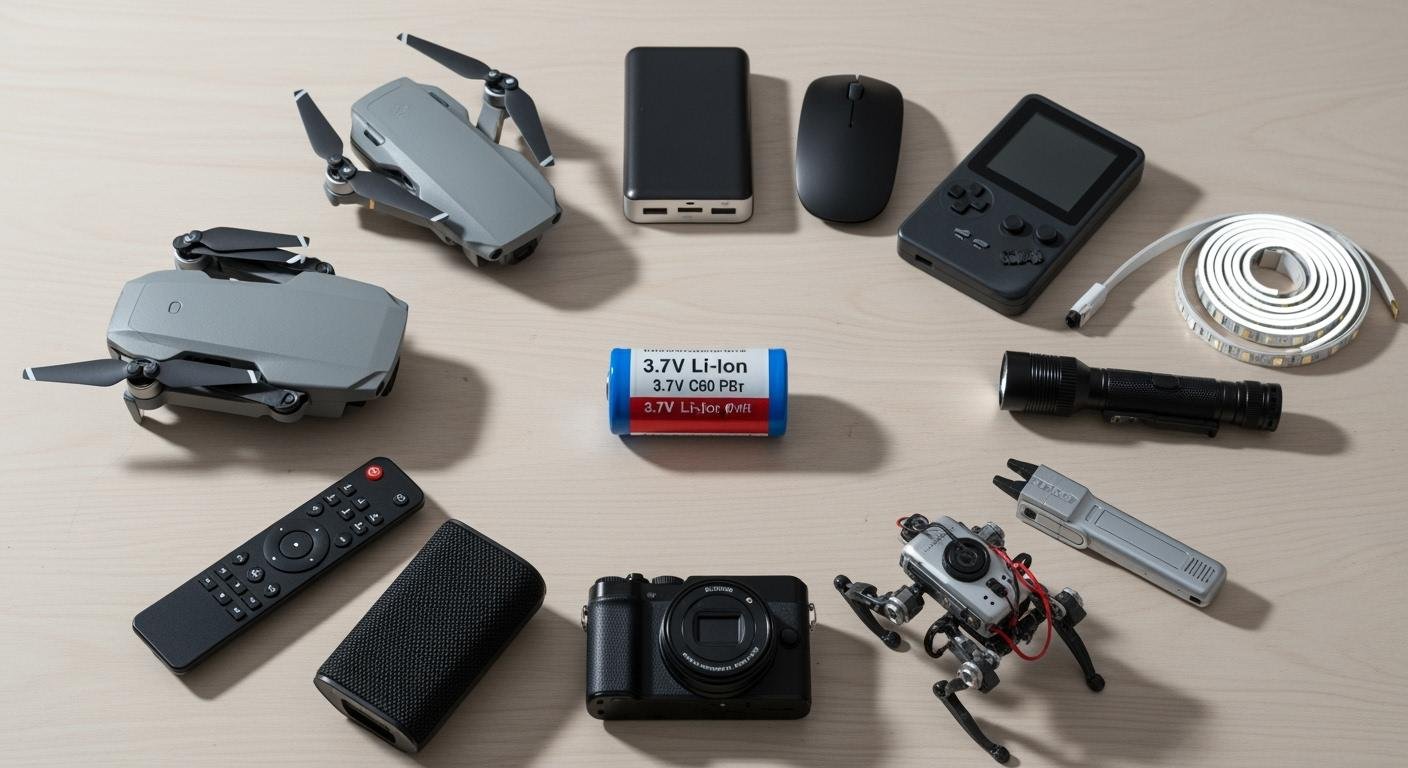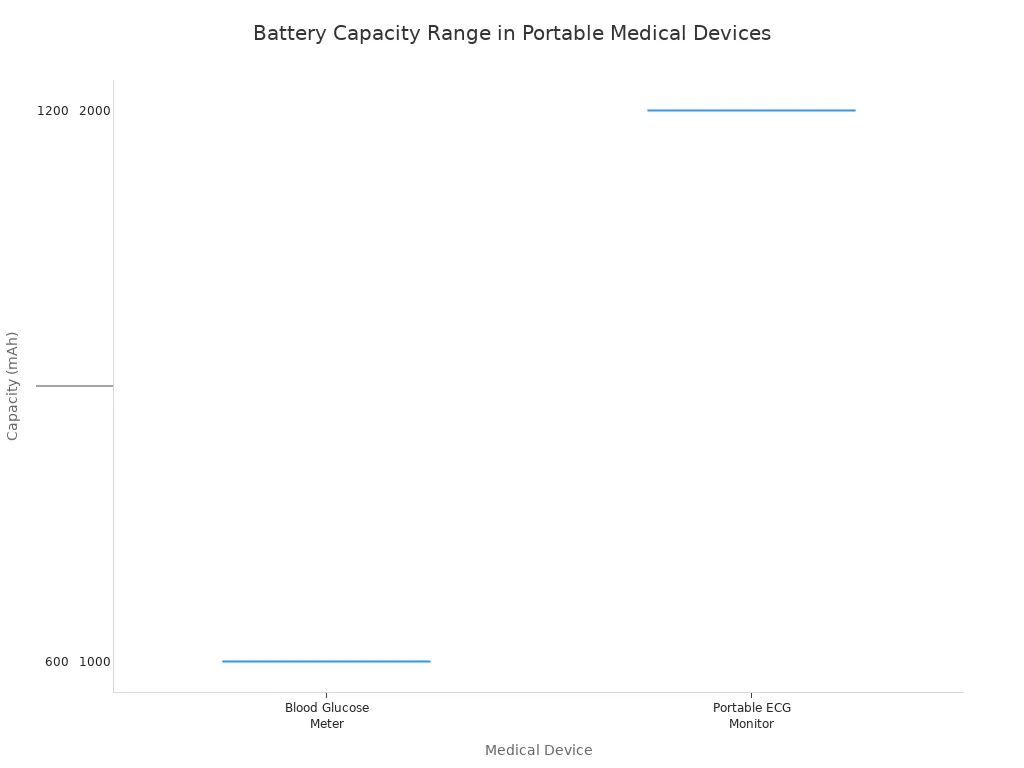
The 3.7V lithium-ion battery powers many common devices. Key applications include:
- Modern Smartphones
- Laptops and Tablets
- Wearable Technology
- Drones and RC Hobbies
- High-Drain Power Tools
- Portable Power Banks
- Vapes and E-Cigarettes
- Personal Medical Devices
- IoT Devices
- E-Bikes and Personal Mobility
Did You Know? The 3.7V lithium battery is a small giant. This specific battery provides reliable portable power for consumer electronics. These lithium-ion batteries are the unseen force in our daily lives. Lithium-ion battery technology offers excellent power density. The diverse applications and even some international uses for these baterías show their importance. We explore why these lithium li-ion batteries are the top choice for so many applications.
1. Modern Smartphones
The 3.7V lithium battery is the heart of modern smartphones. Its unique properties enable the design and performance that consumers expect from these essential devices. The technology directly influences the physical shape, daily use, and charging convenience of today’s smartphones.
Slim Form Factor
Modern smartphones are incredibly thin. This slim profile is possible because of a special type of lithium battery. Manufacturers use Lithium-Polymer (LiPol) cells, a flexible variant of lithium-ion technology. These cells do not need a rigid metal case. Instead, they use a laminate film package. This allows the battery to be molded into thin or custom shapes, fitting perfectly inside compact smartphones. This design choice is critical for creating lightweight and sleek smartphones without sacrificing energy capacity.
All-Day Power Density
A battery must provide lasting power. The 3.7V lithium battery excels in this area due to its high volumetric energy density. These baterías can store a large amount of energy in a very small space, typically between 300 and 700 watt-hours per liter (Wh/L). This high density means that even a small, thin battery can hold enough charge to power a smartphone all day. This balance of size and power is a key reason lithium chemistry is the standard for mobile applications.
Rapid Charging Speeds
Users need their smartphones ready to go quickly. Rapid charging is a major benefit of modern lithium-ion batteries. This feature allows a device’s battery to recharge a significant portion of its capacity in a short time.
Pro Tip ⚡ Many current smartphones can gain up to 50% charge in just 30 minutes. This capability minimizes downtime and keeps users connected.
This fast-charging ability is a practical advantage of lithium-ion battery technology. It ensures that the powerful devices we rely on are available when we need them most.
2. Laptops and Tablets
Laptops and tablets have become essential portable computers for work, school, and entertainment. These powerful devices demand a significant amount of energy to run their processors, screens, and software. The 3.7V lithium cell is the foundation for the larger battery packs that make these portable computers possible.
Powering Portable Workstations
Modern portable computers function as complete workstations. A laptop or tablet needs a reliable energy source to handle demanding tasks. Lithium batteries provide the sustained power required for everything from video editing to complex data analysis. This capability transforms a laptop into a go-anywhere office. The internal design of these computers relies on the compact shape of lithium cells to maximize performance without compromising portability.
Consistent Power Delivery
A laptop requires consistent power for stable performance. Multi-cell lithium-ion batteries achieve this by combining cells in specific configurations.
Manufacturers connect cells in series to increase voltage and in parallel to boost capacity. This design ensures the battery delivers steady power for demanding applications. An advanced Battery Management System (BMS) also monitors and balances each cell. This system optimizes performance and protects the battery from damage.
This careful management provides the stable power needed for high-performance computing.
Lightweight Energy Source
Weight is a critical factor for any portable device. Lithium-ion battery technology offers a high energy-to-weight ratio. This means a lithium battery can store a lot of energy without being heavy. These lightweight baterías help keep the overall weight of a laptop or tablet low. Users can carry their computers easily because the energy source does not add unnecessary bulk. This makes lithium chemistry the ideal choice for mobile computing.
3. Wearable Technology
Wearable technology, such as smartwatches and fitness trackers, requires a very small yet powerful energy source. The 3.7V lithium cell is the ideal solution for these compact devices. Its properties allow for tiny designs without sacrificing essential functions. These lithium batteries enable the continuous operation that users expect from their personal tech.
Miniaturized Power
Wearable devices must be small and lightweight for comfort. The design of a lithium battery is perfect for these applications. Manufacturers can produce these baterías in custom shapes and sizes. This flexibility allows engineers to fit a powerful energy source into a very small space. The high energy density of lithium chemistry provides the necessary power in a tiny package. This makes the slim and ergonomic designs of modern wearables possible.
Long-Lasting Sensor Operation
Fitness trackers and smartwatches use sensors to monitor health metrics 24/7. These sensors need a consistent power source to operate for days at a time. A single lithium battery can run these low-energy sensors for extended periods. This long-lasting performance is a key benefit for users who rely on their devices for continuous tracking.
- WHOOP models can operate for 14+ days with continuous vital monitoring.
- The Garmin Index Sleep Monitor offers up to 7 nights of battery life.
This efficiency ensures that users can track their health and fitness without frequent interruptions for charging.
Extended Battery Performance
The overall performance of a wearable device depends heavily on its battery life. Lithium-ion batteries offer excellent longevity and can be recharged hundreds of times.
Did You Know? 💡 The low self-discharge rate of a lithium battery means it holds its charge well when not in use. This feature ensures the device is ready to go when the user needs it.
This extended performance makes lithium technology the most reliable choice for wearable electronics. It provides the dependable power needed for these always-on gadgets.
4. Drones and RC Hobbies

Drones and radio-controlled (RC) hobbies require a special kind of energy source. These applications demand high performance in a small package. The 3.7V lithium cell is the core component in the battery packs that power these exciting devices. The unique properties of lithium chemistry make it the top choice for flight.
High Discharge Rates for Flight
Drones and RC vehicles need sudden bursts of energy. A high discharge rate means the battery can deliver a large amount of power very quickly. This capability is essential for maneuvers like rapid acceleration, climbing, and hovering. Lithium batteries excel at providing this instant power. This ensures the drone’s motors have the energy they need to perform agile movements. These special lithium baterías give hobbyists the control and performance they expect.
Lightweight for Agility
A drone’s weight directly affects its flight time and maneuverability. Lighter batteries, such as lithium-polymer (LiPo) types, improve a drone’s agility and endurance. A lighter battery helps the drone move quickly and precisely, which is important for drone racing or aerial photography. When choosing a battery, operators must balance energy density and weight. This ensures the drone stays nimble without losing performance, especially when carrying extra items like cameras. The lightweight nature of a lithium battery is a major advantage.
Swappable Power Packs
RC hobbyists often want to extend their flying or driving time. Many drones and RC cars use swappable lithium-ion batteries. This design allows users to quickly replace a depleted battery with a fully charged one.
Hobbyist Tip 🚁 Carrying multiple charged packs allows for hours of uninterrupted fun. This simple feature minimizes downtime and maximizes time spent enjoying the hobby.
This practical approach makes lithium technology ideal for recreational applications. It provides a flexible and user-friendly power solution.
5. High-Drain Power Tools and Li-Ion Batteries
High-drain power tools, such as circular saws and impact drills, demand a large amount of energy in short bursts. These demanding applications require a robust and reliable energy source. Lithium-ion battery technology provides the necessary power for professional and home use. It has transformed the tool industry by enabling high-performance cordless equipment.
Cordless Freedom
The most significant advantage of using lithium-ion batteries in power tools is the freedom from electrical cords. Workers can take their tools anywhere on a job site without searching for an outlet or using long extension cords. This cordless convenience improves safety by reducing tripping hazards. It also increases efficiency, allowing users to move freely and complete tasks faster. A single lithium battery can power a tool for hours, making it ideal for remote locations or quick repairs.
Sustained Torque and Power
Power tools need consistent output to perform difficult jobs. A lithium battery excels at providing a high discharge rate. This means it can deliver a steady stream of energy to the motor, maintaining full power and torque. The tool does not lose strength as the battery level drops.
Job Site Fact 🧰 The high energy density of these special lithium baterías ensures that a drill or saw can cut through dense materials without stalling. This sustained performance is critical for professional results.
This reliable power delivery makes lithium the top choice for heavy-duty tasks.
Durability and Recharge Cycles
Tools used on a job site must be durable. Modern li-ion batteries are built to withstand rough handling and frequent use. This robust design is essential for professional applications. Furthermore, a key feature of lithium chemistry is its ability to be recharged hundreds of times without significant loss of capacity. This long cycle life makes the battery a cost-effective investment over time. This durability ensures that the power source is as tough as the tools it operates.
6. Portable Power Banks
Portable power banks are essential accessories for keeping electronic devices charged on the go. These devices rely on an energy source that is both compact and powerful. The 3.7V lithium cell is the building block for the high-capacity battery packs found inside modern power banks.
High-Capacity Storage
A power bank’s main job is to store a large amount of energy. The high energy density of a lithium battery makes this possible. This feature allows manufacturers to pack a lot of power into a small, lightweight case. Users can easily carry a device capable of recharging a smartphone multiple times. This efficient storage is key to providing reliable portable power for a wide range of personal electronics.
Stable and Safe Output
Power banks must deliver energy in a controlled and safe manner. A well-designed battery includes multiple safety features. A Battery Management System (BMS) provides a high level of safety and contributes to stable output. Manufacturers also build safety mechanisms directly into the lithium cells.
- A PTC (Positive Temperature Coefficient) device stops high current surges.
- A Circuit Interrupt Device (CID) opens the circuit if internal pressure gets too high.
- A safety vent releases gas to prevent a dangerous pressure buildup.
These protections ensure the battery operates safely during charging and discharging.
Why Lithium-Ion Batteries Excel
Lithium-ion battery technology is the top choice for power bank applications. Different types of lithium chemistry offer specific benefits. Lithium cobalt oxide (LCO) provides very high energy density for slim designs. Lithium iron phosphate (LiFePO4) offers exceptional safety and a long lifespan, making it great for rugged power banks. This versatility allows manufacturers to create products for various needs.
Fact 💡 The combination of high energy density, stable voltage, and a long cycle life makes li-ion batteries ideal. A single lithium-ion batteries pack can support up to 1,000 recharge cycles, showing excellent durability.
This balance of performance and longevity is why lithium chemistry dominates the power bank market.
7. Vapes and E-Cigarettes
Vapes and e-cigarettes are popular electronic devices. They need a reliable and compact energy source to function correctly. The 3.7V lithium cell is a common choice for these applications. It provides the necessary power in a small form factor, making it ideal for these handheld products. The specific properties of lithium chemistry help deliver a consistent user experience.
Regulated Power Output
Vaping devices must heat a liquid to create vapor. This process requires a controlled and steady supply of power. A lithium battery delivers a stable voltage, which ensures the device’s heating element works predictably. Many vapes include advanced electronics that regulate the power output from the battery. This regulation allows users to customize their experience while ensuring consistent performance with every use. The stable nature of a lithium cell is key to this function.
Compact and User-Friendly
Vapes and e-cigarettes need to be portable and easy to handle. The small size of a lithium battery helps manufacturers design sleek and pocket-friendly devices. Many models use a removable lithium battery, such as the 18650 cell. This design allows users to swap a depleted battery for a fresh one.
User Tip 💨 Carrying a spare charged battery means users can continue using their device without waiting for it to recharge. This feature adds a layer of convenience for people on the go.
Safety and Reliability
Safety is a major concern for any battery-powered device. Manufacturers of vapes and e-cigarettes must follow strict safety standards for their lithium-ion batteries. In the United States, several regulations ensure these products are safe for consumers.
- UL 8139 is a key standard. It specifically tests the electrical systems, charging components, and battery safety of vaping devices.
- Products must also comply with the Food, Drug, and Cosmetic Act and other federal rules.
These standards help manage the risks associated with lithium technology. They ensure the device’s power system is designed for safe and reliable operation.
8. Personal Medical Devices
Personal medical devices require a consistent and trustworthy energy source. The 3.7V lithium battery is a top choice for these critical health applications. Its reliability ensures that medical equipment functions correctly when patients and healthcare providers need it most.
Reliability for Health Tech
Dependable power is essential for modern health technology. A stable lithium battery ensures that medical equipment operates without failure. This reliability is crucial for a wide range of devices that monitor and support patient health.
- Portable monitors for vital signs
- Baby monitoring devices
- Surgical equipment and robots
- Wearable medical devices
These tools depend on a steady supply of energy to provide accurate data and perform their functions. The consistent output of a lithium battery makes it ideal for these life-sustaining roles.
Powering Portable Monitors
Different portable monitors use specific types of lithium-ion batteries to meet their unique power needs. The choice of battery depends on the device’s size, function, and energy consumption.
| Medical Device | Type de batterie | Capacity Range | Tension | Special Requirements |
|---|---|---|---|---|
| Blood Glucose Meter | Lithium Polymère (LiPo) | 600–1200 mAh | 3.7V | Ultra-thin, fast charging, long standby |
| Portable ECG Monitor | Cylindrical Li-ion | 1000–2000 mAh | 3.7V | Stable output, safety circuit protection |
| Pulse Oximeter | Rechargeable Li-ion | 300–600 mAh | 3.7V | Lightweight, frequent charging cycles |
| Insulin Pump | Custom LiPo or Li-ion | 800–1500 mAh | 3.7V | Long duration, strict medical compliance |

This careful selection ensures each monitor has the right balance of size and energy for its specific task.
Long-Term Performance
The lifespan of a battery is a key factor in medical device design. A lithium battery in medical equipment typically lasts between two and five years. This lifespan equals about 300 to 500 full charge cycles.
Medical Fact 🩺 A 2022 study showed that lithium batteries in portable monitors kept 85% of their capacity after 400 cycles. This demonstrates their excellent durability for long-term use.
To ensure maximum safety, many healthcare facilities replace these batteries every three to four years. This practice guarantees the devices remain reliable for patient care.
9. Diverse ‘Aplicaciones’ in IoT Devices
The Internet of Things (IoT) connects countless smart objects to the web. These devices need an energy source that is efficient, long-lasting, and small. The 3.7V lithium battery meets all these needs, making it a key component in the world of smart technology. Its unique properties support the diverse aplicaciones found in this growing field.
Low Power Consumption
Many IoT devices are designed to use very little energy. They often operate in a low-power “sleep” mode and only “wake up” to send small amounts of data. A lithium battery is perfect for this function. It provides a stable voltage and works efficiently with electronics that draw minimal power. This allows a single battery to operate a device for a very long time, which is essential for creating a reliable network of connected objects.
Long-Life for Remote Sensors
IoT sensors are often placed in locations that are difficult to access, such as on remote equipment or inside building walls. The low self-discharge rate of a lithium battery is critical for these situations. This feature allows the battery to hold its charge for months or even years without significant energy loss. It retains its power far better than other battery types.
Did You Know? 🛰️ Industrial-grade lithium batteries can operate for up to 20 years. This extended life is perfect for remote IoT devices because it greatly reduces the need for costly and difficult battery replacements.
This long-term reliability makes lithium technology the most practical choice for remote monitoring.
Compact Size for Smart Tech
Smart technology is getting smaller and smaller. Devices like asset trackers, smart buttons, and environmental sensors must be compact and lightweight. Lithium-ion batteries have a high energy density, meaning they can store a lot of power in a tiny package. This allows engineers to design small, unobtrusive products without sacrificing performance. The compact lithium battery provides the necessary energy while keeping the overall size of the smart devices minimal.
10. E-Bikes and Personal Mobility

E-bikes and other personal electric vehicles need a strong and lasting energy source. The 3.7V lithium cell is a key part of the larger battery packs that drive these modern modes of transportation. The properties of lithium chemistry make these personal electric vehicles practical for daily use.
Powering Electric Motors
Electric motors in e-bikes and scooters require significant power to move a rider. A lithium battery pack provides the high current needed for quick acceleration and climbing hills. This consistent power delivery ensures a smooth and responsive ride. The stable voltage from a lithium battery helps the motor operate efficiently. This makes these personal electric vehicles a reliable choice for commuting.
Long-Range Travel
The distance an e-bike can travel on one charge is a major factor for users. High-capacity lithium-ion batteries allow riders to travel long distances. A single charge can often last for 20 to 60 miles, depending on the terrain and riding style.
Rider Fact 🚲 The high energy density of a lithium battery means it stores a lot of energy in a compact size. This feature is essential for personal electric vehicles, where space and weight are limited.
This long-range capability makes these electric vehicles a great alternative to cars for many trips.
Managing Battery Weight
The weight of the battery pack affects how personal electric vehicles handle. A heavier battery can make a bike slower to accelerate and harder to maneuver. It requires more energy to move, which can reduce the effective range. In contrast, a lighter lithium battery improves agility and makes the bike feel more responsive. Manufacturers of electric vehicles must balance battery capacity with overall weight. A lighter frame and an efficient motor can help extend the battery life of these electric vehicles. This careful management ensures the best performance and handling.
The 3.7V li-ion batteries power a huge range of products, from power tools to medical devices. The core benefits of lithium-ion battery technology—high energy density and light weight—drive modern portable power. Future rechargeable lithium batteries promise even more exciting developments. The future of portable power looks bright with advancements in lithium chemistry.
- Solid-state lithium battery designs will improve safety and capacity.
- Smart features will allow lithium-ion batteries to self-diagnose their health.
This constant innovation ensures li-ion batteries will continue to power our world.
FAQ
What is a 3.7V Li-Ion battery?
A 3.7V Li-Ion battery is a type of rechargeable power cell. The 3.7 volts represents its nominal or average voltage. This battery is popular in electronics because it stores a lot of energy in a small, lightweight package, making it ideal for portable devices.
Are 3.7V Li-Ion batteries safe?
Yes, these batteries are safe with correct handling. Manufacturers include safety features to prevent overcharging and overheating. Users should always follow the device’s guidelines for charging and storage. Proper care ensures safe operation and a long battery life.
How long do these batteries last? 🔋
The lifespan of a Li-Ion battery is typically 300 to 500 charge cycles. For most consumer devices, this equals about two to three years of regular use. After this time, the battery still works but will hold less charge than when it was new.
Why is 3.7V a common voltage?
The 3.7V rating comes from the battery’s internal chemistry. This specific voltage provides an excellent balance between high energy density and stable power output. It is a very efficient level for powering the majority of modern portable electronics, from phones to medical devices.

